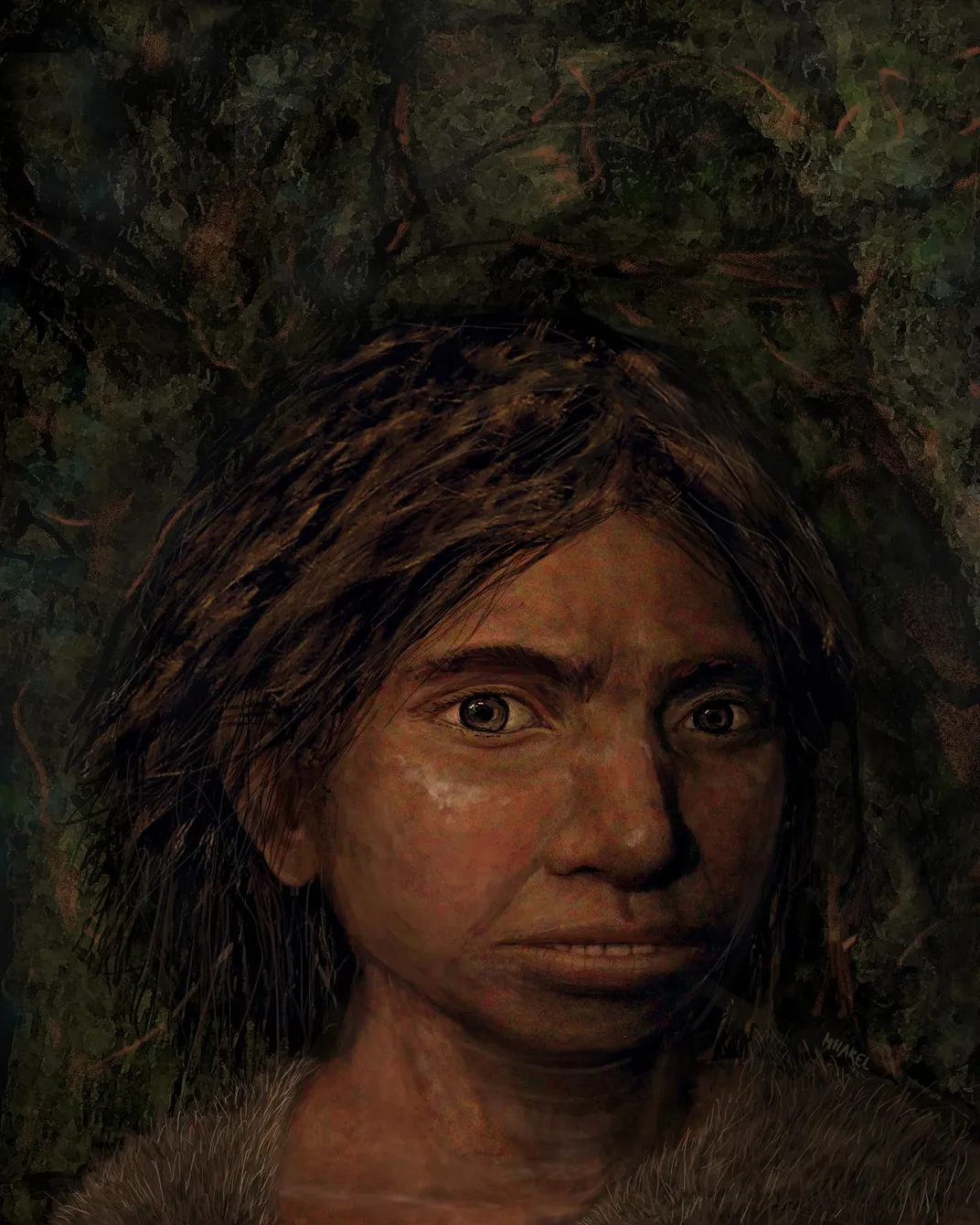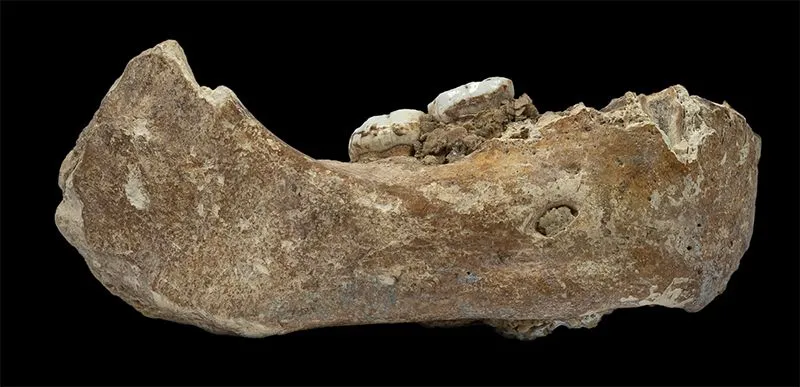Scientists Recreate the Face of a Denisovan Using DNA
By mapping gene expressions, researchers can determine some anatomical features of our distant hominin relatives
:focal(1489x1944:1490x1945)/https://tf-cmsv2-smithsonianmag-media.s3.amazonaws.com/filer/19/3f/193f03e0-b70e-4bf4-982e-a267fea0d254/211253.jpg)
Denisovans are a mysterious group of our ancient relatives, unknown until a decade ago, who lived alongside Neanderthals and Homo sapiens. The hominin species is thought to have ranged from Siberia to Indonesia, and many places in between (although some researchers believe the Denisovans could actually be multiple species or groups). When these curious human cousins vanished, they left behind surviving bits of their DNA in living Melanesian and East Asian people, but not much else. So far, the only known Denisovan fossils include just a few teeth, a finger bone and a small fragment from a Russian cave, and a partial jaw found on the Tibetan Plateau.
Yet today it’s possible to stare into a Denisovan face for the first time thanks to a striking reconstruction created by some genetic detective work. Scientists used patterns of gene expression mined from ancient Denisovan DNA, which was extracted from a 100,000-year-old pinkie finger, to reconstruct the physical characteristics of a Denisovan face and skull—even though such a fossil has never been found.
Geneticist Liran Carmel of the Hebrew University of Jerusalem said other groups have worked to map anatomical features from the information hidden in our DNA. But his team took a different approach, outlined in a study published today in Cell.
“We didn’t rely on the DNA sequence per se,” Carmel says. ”But from the sequence we used a technique which allows you to reconstruct gene activity patterns in these ancient individuals so we can compare the way the genes work in the different human groups.”
/https://tf-cmsv2-smithsonianmag-media.s3.amazonaws.com/filer/27/4f/274fe2b2-5539-419c-98ac-9366bb6952b7/211254_web.jpg)
The addition of methyl groups to DNA, or molecules derived from methane, impacts the ways genes activate and express themselves, in turn determining what physiological traits those genes produce. Carmel’s group mapped these methylation patterns to recreate the likeness of a young female Denisovan, which the pinky bone belonged to. “Evolutionarily speaking, it’s well known that many anatomical or physiological differences between closely related groups are attributed to changes in gene activity patterns. This is exactly what we can find using our technique,” Carmel says.
Chris Stringer, a paleoanthropologist at the Natural History Museum, London, who was unaffiliated with the study said via email that the reconstruction of Denisovan anatomy is “a pioneering piece of research, which at first glance seems almost like science fiction. This is exciting work, pushing the boundaries of what can be gleaned from ancient genomes.”
The technique—mapping methylation patterns in DNA to determine gene expression and anatomy—is still fairly new. “The research relies on a complex chain of extrapolations,” Stringer says. It cannot show us with perfect accuracy what a Denisovan looked like, but earlier research of Neanderthal and Denisovan DNA suggested methylation changes could be used to explain anatomical differences. For the new study, when Carmel and colleagues tested their technique against known Neanderthal and chimpanzee anatomy, they found a close match.
Using these types of epigenetic techniques to predict the traits of living humans is still difficult, so applying it to the ancient DNA of an extinct hominin species has its limitations. Denisovans, a little-known hominin group that may be comprised of at least three different lineages, were uncovered a decade ago with a bare handful of tooth and bone fragments found in a cave called Denisova in Siberia’s Altai Mountains. They were the first human group to be named by DNA evidence, as only genetics revealed that the fossil fragments were from people distinct from Neanderthals. Like Neanderthals, they likely descended from an ancestral population that branched off from our own modern human family tree between 520,000 and 630,000 years ago.
But the branches of that tree continued to intertwine for many thousands of years. DNA reveals that modern humans, Neanderthals and Denisovans interbred—perhaps more frequently than we might imagine. These ancient interspecies liaisons made headlines last year when a 90,000-year-old female found in a Siberian cave turned out to be the first generation hybrid offspring of a Neanderthal mother and Denisovan dad.

Carmel and colleagues mapped out Denisovan, Neanderthal and human DNA to find regions where methylation patterns differed. They then looked at modern disorders that impact the function of those same genes to try to find out what kinds of anatomical changes the ancient pattern variations might have caused. For this they employed the Human Phenotype Ontology database, which charts the genetic underlies of some 4,000 human disorders, and has produced a catalog of more than 100,000 gene-phenotype associations.
“Basically, from the DNA sequence, we infer which genes have changed their activity level across the human groups and from this we make inferences about changes in anatomy,” Carmel says.
By this method the team was able to reconstruct what a complete Denisovan skull and face might have looked like. They then put the method and its reconstruction predictions to the test, despite the lack of a Denisovan skull that could show how accurately the DNA evidence predicted various features of its anatomy in their reconstruction.
“We tested the approach by pretending that we don’t know what a Neanderthal or a chimpanzee looks like. So we reconstructed their anatomy and then compared the results to what is known.”
As it turned out, real-world Neanderthal and chimpanzee fossils showed that 85 percent of the trait reconstructions accurately predicted anatomical features, like a shorter or longer section of jawbone.

While the completed study was under peer review, an incredible opportunity arose—the discovery of an actual Denisovan jaw. The 160,000-year-old jawbone was found high on the Tibetan Plateau and identified as Denisovan through the analysis of proteins preserved in the teeth. Carmel and colleagues had a chance to check their work against an actual Denisovan fossil.
“This was very exciting for us,” Carmel says. “When we submitted the paper to Cell we only had a few teeth and a finger bone to compare to our predictions. We immediately went to check how it compared to our predictions. And we find a beautiful match, so this was very reassuring for us.”
Stringer agreed that the method has produced some intriguing matches with the fossil record, though it didn’t always hit the mark. “The results suggest that Denisovans should have features such as a low braincase, a wide pelvis and large joint surfaces and ribcage. Of course, our knowledge of real Denisovan anatomy is very limited, but features such as a long and robust jaw (from the Xiahe mandible), and a flattened and broad braincase (from the only known skull fragment) do seem to match the method’s predictions,” he says via email. Stringer noted that other characteristics, like thicker enamel and broader fingertips compared with modern humans, didn’t match as well.
More Denisovan fossils could not only flesh out what the skulls and faces looked like, but further refine the predictive abilities of DNA methylation patterns.
“There are skulls and partial skeletons from Chinese sites such as Jinniushan, Dali, Harbin and Xuchang that might also represent Denisovans, although we don’t yet have their DNA or ancient proteins to test this,” Stringer says.
If the skulls found in China are Denisovan, they would support the predictions in features like strong brows, wide skulls and a wide pelvis, but their faces would not project Neanderthal-style as the methylation prediction would suggest. Further muddying the waters is growing evidence from both modern and ancient DNA suggesting that the hominins currently dubbed ‘Denisovan’ may well be a very diverse group that stretched across Asia.
“In reality, their anatomy is likely to have shown substantial variation through space and time,” Stringer says.
As genetic reconstructions improve, and additional fossils are found to check the predictions, this research could reveal what many early humans looked like. Scientists might even be able to produce an entire gallery of ancient faces, painting a family portrait of long-vanished relatives we could previously only imagine.